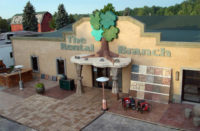
You are walking in the mall one day and notice a beautiful concrete floor in a national retail store. You think, “I could do that.” But how do you get those accounts? How do you expand your service area?
Why you should, and when
You already have the expertise in decorative concrete. You have many projects in your local area that people always comment on. You have even received inquiries from a large retail chain that is opening a location in your area. You have many projects on your schedule for the next few months, but they are on the small side.
Decorative concrete is a growing trend all across the country. From retail to restaurants to homes, it is more in demand. How can you tap into this exciting trend?
Research your target audience. Are they general contractors, architects or designers? Who makes the ultimate decision regarding who does the work? It has been my experience that unless a particular decorative concrete contractor has been requested by either the owner or the architect, the general contractor makes the decision.

Try to find the top 100 general contractors in the country. These are usually the ones with larger national clients. Send them information on your company. Call and speak with the head estimator. Getting your name out there is the biggest step.
Ready, willing and able
All your hard work has paid off. A national retail chain is opening 14 stores in the next 12 months and they want all their floors to look the same. They want you to do them. The new stores are spread out across the country. You think, “This is what I have been waiting for!” But are you ready?
You have landed that big account. Now, logistically, how do you do this job? You could use all your own employees. They are experienced, and they can get the job done. But one has a new baby and can’t leave home, and another is afraid to fly. This certainly puts a damper on your excitement.
You could call a supply house in the area near the new project and get some recommendations on help. Most supply house reps know their customers and what they do. An employment services company is another good alternative. They can match you with skilled or unskilled labor to help out.

Do you have to be licensed for the state in which you are working? Will your liability insurance and workers’ compensation carriers allow out-of-state work? These are important details.
Will the client pay upfront for airfare, hotel and rental truck? Or do you have to put that money up and wait for 45 days to be reimbursed? This is a problem for many of us.
Once these questions have been answered, you can begin arrangements. Arrange for a rental van your crew can pick up at the airport. Be careful, however, to be certain that you can pay for the van over the phone. Many rental companies require the person driving to also pay for the van. You could open a prepaid credit card for your foreman for this purpose.
This prepaid credit card may also be used to purchase supplies you will need. Unless you have an account with a national supply house, you will have to pay cash for most of your tools and materials. And don’t forget about food and gas.

The hotel, supply house and job location should be as close together as possible. Don’t go for a hotel 40 miles away just because they can give you a great price. The client must understand that they may have to pay a little more for the convenience of a local hotel. Make it clear that it is necessary to be close because you will probably be working at night (because of mall rules) and the safety of your men is your paramount concern.
Set up your labor beforehand. Get the potential help’s contact information and call them directly. You should get a sense that they are dependable, capable, and willing to work in a high-pressure situation.
Be sure to speak directly with the job superintendent about job-site conditions. Are electrical, water and lighting available and set? If the floor must be shot-blasted, can the superintendent send you a page from the local phone book so you can set it up? Where do deliveries go? From where do you stage your work?
Another suggestion is, if the project is in a mall, speak directly with mall management. Introduce yourself and discuss the project with them. Tell them you are coming from another state and want to be sure about mall hours of work, where deliveries can go, the staging areas, and any particular rules you must follow concerning your work.
Now, you must think about your tools. Do you fly with them? Do you buy new ones?
Some tools you probably want to bring along with you, such as trowels that are broken in just the way you want them. Check with the airline to get any restrictions they may have. You could box the tools and check the boxes in with your baggage. Airlines usually allow two checked bags per person, so each man could bring a box of tools, but be aware of weight restrictions. You can’t bring brooms, fans or a Skilsaw, so be prepared to buy those things at the job location. And be prepared to leave them. I have spent more than $1,000 on tools at job locations and been forced to leave them to the general contractor, or perhaps another deserving tradesperson.
Because of the increased security restrictions at airports, be sure that each man in your crew has a valid, up-to-date driver’s license or another piece of required identification. The last thing you need is to be all set for a job and have a major setback because one of the best guys on your crew is turned away because of an expired driver’s license.
Getting into the groove
The first couple of jobs can be frustrating. Problems can and will come up. But once you get into the flow of the projects, they become much easier. You know the exact materials you need and you have your timing down to a science. Your crew finds the groove, and they mesh into a well-rounded team. Your clients see that you are doing a great job and they loosen the purse strings to get you an advance on the next project to cover travel expenses upfront, easing your cash flow.
















